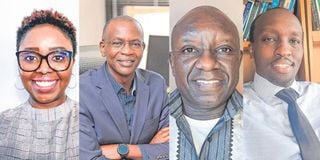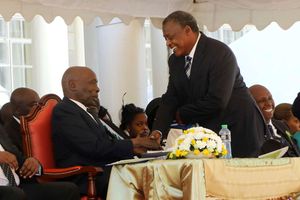
Dr Caroline Kingori, Prof Kefa Otiso, Prof David Monda, and Geoffrey Kipkemboi Kangogo are Kenyans lecturers teaching at US universities.
Attention, class! Today, we take a mental flight to the United States, where we meet four Kenyans who are lecturers at various universities here.
They discuss the highs and lows of their jobs, their commonest concern being long working hours. Theirs is a job that is impossible to confine within the 9am-5pm barriers, they said.
We enquired whether university students in the US are the rude type as depicted in some movies and other works of fiction. There was no uniform answer here. Some said it was a mischaracterisation, but there were intermittent admissions that students over there can be downright difficult. Another said it is all to do with the freedom of expression that is entrenched over there.
What of the differences in the education systems of Kenya and the US? The lecturers made it sound like the Kenyan system is a cattle dip — figuratively speaking. Animals are forced into one end and must leave on the other. In the US, they noted, there are more exits and more room to wander about. Now, class, let’s hear from them.
Prof Kefa Otiso, Geography professor, Bowling Green State University

Prof Kefa Otiso comes from Nyamira County, and has taught over 4,500 students so far.
From Nyamira County, Prof Otiso is an alumnus of Kineni Primary School, Menyenya High School, Gusii Highlights and Kenyatta University where he was admitted in 1987 to train as a Geography and Kiswahili teacher. He later got a scholarship to study for a master’s at the Ohio University. He completed that in 1993 and enrolled for a PhD at the University of Minnesota. He took a dive into lecturing in 1999 when he got a junior lecturer position at Bowling Green State University. His areas of specialty are urban and economic geography; and applied geographic information systems. He has taught over 4,500 students and is currently the director of the Global Village Learning Community.
Q: What has been your experience as a Black lecturer in the US?
The experience of teaching at a US university can vary depending on the State you live in and the type of university you teach at — whether a historically black, Hispanic, or white university, liberal arts college, or a research university. The courses and subjects that you offer, and whether at the undergraduate or graduate level or both can also influence one’s experience.
Thus, African immigrant professors in science, technology, engineering, and mathematics deal with less controversial material than those in the social sciences where emotive subjects like race, ethnicity, religion, and politics are frequently covered.
Overall, I have had an enjoyable and rewarding experience even though most of us African immigrant professors often deal with considerable culture shock when we start teaching at US universities and colleges. For us and our students alike, this culture shock, at least initially, stems from our different cultural backgrounds, accents, and expectations.
Because of frequent negative portrayals of Africa in the US media, the complicated history of US-Africa relations since the days of slavery, limited African history and geography content in the US elementary and secondary school curriculum, and misinformation, many US students do not always know what to make of us until they get a chance to know us better. Few have good, detailed knowledge of Africa.
For many, Africa is one small homogeneous country rather than a massive continent with 54 different countries, and massive differences East-West and North-South distances. As a result, it can be simultaneously challenging and rewarding to teach courses like African history and geography in US universities.
Q: Comment on the main challenges you face.
One is that many US students are often not as motivated to study as Kenyan students because the US has many economic opportunities that can be accessed without a college education. Moreover, many of them tend to come from relatively well-off backgrounds. For minority students, for instance Blacks and Hispanics, the challenge is often poor preparation for university education because many of them come from poor families and under-resourced primary and secondary schools.
Also, there is the emerging problem of artificial intelligence (AI) and academic honesty issues. US students have widespread access to technology, including AI tools like ChatGPT. This technology has in the last couple of years made it harder for lecturers to use certain take-home assessments and assignments because AI can easily generate good responses for them. Consequently, US lecturers are busy retooling their courses to promote academic honesty and to even incorporate good uses of AI.
In some cases, this retooling has meant going back to time consuming pen-and-paper assessments. Most students are honest, but there are those who can’t resist the temptation to use shortcuts like those provided by AI. Although tools for detecting AI-generated text responses are getting better by the day, one has to stay vigilant to ensure that students actually do their work rather than outsourcing it to AI or hiring surrogates in places like Nairobi.
Q: What about working hours?
On paper, our normal workday is eight hours a day, 40 hours a week, however, research and other work responsibilities often tend to require many US professors to work well past normal working hours without overtime pay because many are salaried. Although many of them are reasonably paid, the country’s high cost of living and fast pace of life generally tends to make it hard to maintain a good work-life balance.
Q: How do the Kenyan and the US education systems differ?
Universities in the US are much better endowed and managed compared to their Kenyan equivalents. Part of the reason for the dire Kenyan university situation is the reckless expansion of the Kenyan university system in the last two decades in response to parochial ethnic political pressures rather than genuine national labour force and technological needs.
The result? Too many universities than the country needs or can realistically fund or support. Unsurprisingly, Kenyan universities generally have large class sizes that undermine learning. At the postgraduate level, Kenyan lecturers supervise way too many students, leading to slow progression, high dropout rates, and poorly prepared graduates that do not serve the country well.
To reverse this situation, it is necessary to consolidate Kenya’s existing public universities into a few large ones that can have enough financial, physical, and human resources to be effective, efficient, and more productive and impactful.
Q: Have you had to deal with rude students?
Well-behaved and rude students exist everywhere. Many of the poorly behaved ones are often students needing attention for one reason or another. Proper communication and enforcement of classroom policies is usually enough to deal with such students. Also, empathy goes a long way, more so when students are acting out because of factors like tough home situations.
Over the years, I have found that knowing your students and building good relationships with them and being a knowledgeable and effective professor attracts student respect and greatly minimises many cases of student misconduct in class.
An authoritative (not authoritarian) teacher who effectively meshes structure with clear classroom expectations, warmth, and support can do well in the American classroom. Once students know that you care about them and their future, they tend to behave themselves.
Additionally, some of what comes across as student misconduct in movies is often a product of using a Kenyan cultural lens to make sense of US culture and behaviour. Freedom of expression is one of the central aspects of American culture that also shows up in their classrooms. Used well, it can add a lot of value in the classroom.
Talkative and assertive students are, therefore, not necessarily rude. We also should not assume that the quieter and less assertive Kenyan student is necessarily more disciplined than his/her American counterpart or that the Kenyan classroom promotes learning more effectively than its American equivalent.
Prof David Monda, Political Science lecturer, City University of New York

Prof David Monda Political Science lecturer, City University of New York.
He was born and raised in Nairobi, completing his primary education at the Lang’ata Junior School in 1987 and later studying at Kakamega High School. Afterwards, he joined the United States International University-Africa, from where he got a scholarship to go to the US to pursue a master’s degree. His areas of speciality are comparative politics, international relations and comparative migration in the global south. He started off as a lecturer at the Grand Canyon University in 2008. An approximate 3,000 students have gone through his hands to date.
Q: Any other positions you hold in your institution?
I chair the Africa Research Group, a policy-based think tank centred at the Graduate Centre of the City University of New York.
Q: What is it like being a Black lecturer in the US?
As a scholar that happens to be Black, it is important to understand and be able to navigate a highly racially polarised work environment such as that in the US. I have found the best way to do this is to strive to be excellent in my professional work by going beyond the call of duty. It is also important to understand the history of education policy in the US to better reach out to the diverse cacophony that is the student population in many of my classes.
Q: The main challenges you face?
Maintaining a work-life balance, lack of sufficient support from university administrations, and keeping current with the rapidly changing literature in my field of study (political science).
Q: How do the Kenyan and the US education systems differ?
Funding for research and faculty development is abundant in the US but lacking in Kenya. Faculty unions and administrations work better in the US. They are more collaborative. In Kenya, because of the history of political interference in the running of public universities, faculty unions and administrations tend to have highly conflictual relationships on issues like faculty pay, research funding, terms of service for faculty and student welfare.
I also think US students are a lot more open to challenging faculty positions on material taught, while in Kenya, the faculty-student relationship is more hierarchical. Also, Kenyan students tend to be more respectful of faculty and want to work harder than many US students. Kenyan students also have a better sense of world geography and history than their US counterparts.
Q: Is the US teeming with rude students?
US students can be very rude to faculty. But it is also a question of how faculty approach conflicts with students. It is important for faculty to continuously get training to meet the needs of a diverse student population while also maintaining the classroom discipline to support a learning environment that is healthy and enabling for all students to learn effectively.
Purposive training to anticipate potential conflict with students before it happens is, therefore, important. Students in the US have a great amount of power in the classroom as administrations have tried to improve the learning environment in the classroom. This student power can sometimes flare out of hand.
Dr Caroline Kingori, Associate professor (community and public health), Ohio University

Dr Caroline Kingori, Associate professor (community and public health), Ohio University.
She was born and raised in Nairobi, attending Kimathi Primary School and later Huruma Girls before she joined the Kenya School of Monetary Studies where she got a diploma in banking and finance. She, however, had a burning passion for psychology, and she successfully applied for admission at Morgan State University. That was the beginning of her journey to where she is today — an expert in community and public health. She has been in the US for 21 years. So far, she has taught more than 500 students and is currently an associate dean for faculty affairs.
Q: What are your experiences of being a Black lecturer in the US?
Being a Black person teaching in the US is a multifaceted experience.
It entails being a source of representation for racial and ethnically diverse students, offering a valuable perspective on the cultural and historical experiences of Black and Brown communities. It also involves a commitment to promoting inclusivity and equity in education, advocating for diverse perspectives, and addressing discrimination or microaggressions when they arise.
Despite its challenges, being a Black educator in the US is an opportunity to make a meaningful impact on students and contribute to a more inclusive and equitable educational system.
Q: What are the main challenges you face?
Lecturers worldwide encounter a multitude of challenges in their profession. They include the balancing act of managing teaching loads, accommodating diverse student needs, and staying abreast of ever-evolving teaching advancements.
Lecturers also grapple with maintaining a productive research agenda alongside their teaching responsibilities, as well as the time-consuming task of assessing and grading assignments and participating in committees to fulfil their service expectations.
Q: Comment on your working hours?
Working hours as a lecturer are undoubtedly demanding and frequently extend well beyond the standard 9-to-5 schedule. Lecturers often find themselves dedicating long hours, including evenings and weekends, to the various facets of their profession.
Striving for a work-life balance is an ongoing effort, but many lecturers are motivated by their passion for teaching, dedication to their students’ success, and their commitment to research and community service, making the long hours a labour of love in the pursuit of educational and scholarly excellence.
Q: There must be a difference in education systems in Kenya and the US…
One of the prominent distinctions lies in the structure and flexibility of education. The US system offers students greater freedom to select courses beyond their major, fostering a well-rounded education, while Kenya tends to have a more structured curriculum with limited room for exploration. Additionally, the US places a strong emphasis on specialisation and diverse assessment methods, including class participation and presentations, promoting a holistic evaluation of students. In contrast, Kenya traditionally relies heavily on final exams for grading.
The teaching styles also vary, with the US favouring interactive and critical thinking-oriented methods, while Kenya often leans towards traditional lecture-based approaches. Access to resources, financial considerations, and the global perspective also significantly differ between the two systems.
Q: There is the perception that students in intuitions here generally have low regard for lecturers...
The students I have taught have been respectful, and I reciprocate that respect. I have learnt not to use a one-size-fits-all approach for all my courses, instead, I contextualise them to be relevant to both undergraduate and graduate students. Any challenges in the student-lecturer dynamic, which are often minor, may arise from communication gaps, differing expectations, and occasional disagreements. However, I haven't encountered outright rudeness and standoffs in my teaching experience.
Geoffrey Kipkemboi Kangogo, Adjunct professor (epidemiology), Saint Louis University

Geoffrey Kipkemboi Kangogo, Adjunct professor (epidemiology), Saint Louis University.
Born in Baringo, Mr Kipkemboi is a scientist whose passion is taking him places. He studied at Kalel Primary School, completing his studies in 2001, and later at Moi High School Kabartonjo before he joined the Jomo Kenyatta University of Agriculture and Technology to study biochemistry and molecular biology.
He is currently a PhD candidate at the College for Public Health and Social Justice at the same university where he has been a lecturer since last year. He went to the US courtesy of a full scholarship. Before that, he was working at the Health Ministry under the National Aids and STI Control Programme. So far, he has taught 47 students. He is a graduate research assistant.
Q: What has your teaching experience been like so far?
It has been an enriching and multifaceted experience, providing me with both challenges and opportunities to make a meaningful impact. One of the most significant aspects has been the ability to serve as a role model and mentor to students from diverse backgrounds, especially those who may not have previously seen their identities reflected in academic leadership.
Q: The main challenges you face?
There is a need to deal with the rapidly evolving educational technology and integrate these advancements effectively into the curriculum to ensure that the learning experience remains dynamic and engaging. It is also critical to address the diverse needs and learning styles of students, which requires continuous adaptation and innovation in teaching methods.
Q: How do you find the working hours?
My working hours extend beyond the traditional classroom schedule, encompassing not only the time spent teaching, but also preparing lectures, grading, conducting research, and meeting with students. This role demands flexibility and often involves early mornings, late evenings, and occasional weekends to accommodate various academic responsibilities and deadlines.
Q: What are the difference between the education systems here and in Kenya?
The US system emphasises a more interactive and student-centred approach, fostering critical thinking and encouraging students to actively participate in their learning process. In contrast, the Kenyan system, while rich in content and rigour, often leans more towards a traditional lecture-based format with a stronger focus on standardised examinations. Another notable difference is the access to resources and technological integration in the classroom where the US universities generally have greater access to cutting-edge educational technology, which significantly enhances the learning experience.
Q: What has been your classroom experience in terms of interaction with students?
The depictions in movies of students being outright rude and having standoffs with their lecturers are generally exaggerated and not true to the typical student-lecturer relationship. Most students are respectful and engaged. While differences in opinions or debates may occur, they are usually conducted professionally and constructively.









